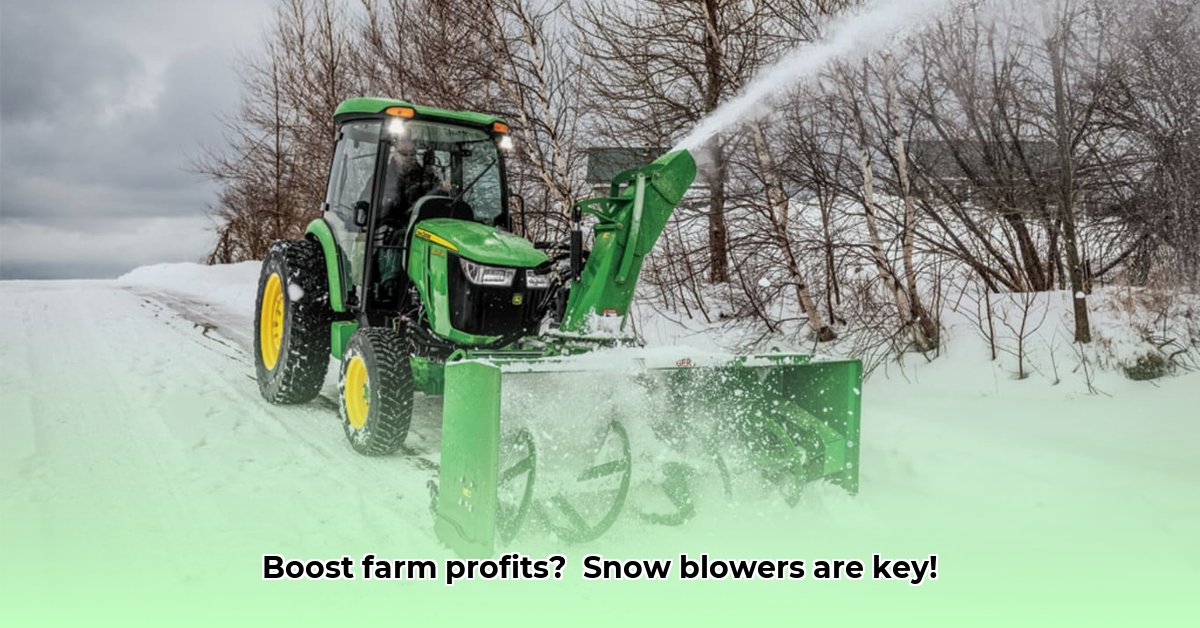
John Deere Snow Blowers for Tractors: Extending Your Farming Season and Income
Don't let winter idle your farm! This guide shows you how integrating John Deere snow blowers with your tractor can generate year-round income and extend your operational capabilities. We'll cover equipment selection, safe installation and operation, financial considerations, and planning strategies to maximize your return on investment (ROI). Let's transform those snowy months into profitable ones. For more information, check out this helpful resource: Learn More.
Choosing the Right John Deere Snow Blower: A Strategic Decision
Selecting the optimal snow blower isn't simply about choosing a model; it's about aligning the equipment with your specific needs and farming conditions. Several key factors will guide your decision.
Tractor Compatibility: Ensure your tractor has sufficient horsepower to handle the snow blower's demands. Consult your tractor’s manual to confirm compatibility; mismatched equipment is a safety hazard and impacts efficiency. Don't overestimate your tractor’s capabilities.
Anticipated Snowfall: Heavy, frequent snowfall necessitates a more powerful blower with a wider clearing path and robust auger. Lighter snowfall may only require a smaller, less powerful model. Assess your local climate patterns.
Area to be Cleared: The scale of your operation dictates the blower's size and power needs. Clearing a small driveway is different from clearing large fields or extensive farmlands. Consider the required clearing width and capacity.
Budgetary Constraints: John Deere provides a range of snow blowers; carefully consider your budget before making a purchase. While premium models offer enhanced features, a more economical option might suffice for smaller operations.
Installing and Operating Your John Deere Snow Blower: A Safe, Step-by-Step Approach
Attaching the snow blower is straightforward with careful attention to detail and safety. Always follow these steps:
Prioritize Safety: Always consult your owner's manual before commencing the installation process. It is crucial to put on safety glasses, sturdy gloves, and any other recommended protective gear. Critically, always disconnect the PTO (power take-off) before attaching the blower to prevent accidental engagement; this is paramount to preventing injuries.
Secure Attachment: Carefully attach the blower to your tractor's three-point hitch, ensuring all connections are secure and tight. Double-check everything before starting the tractor.
Familiarization and Start-up: Before starting the tractor, thoroughly review the blower's controls. Begin operation slowly, testing the controls cautiously. Adjust the chute for effective snow discharge; aim away from obstacles and buildings.
Safe Operation Practices: Maintain a safe speed and pay close attention to your surroundings. Avoid operating in poor visibility or when fatigued. Consistent maintenance, including lubricating moving parts, is crucial for longevity and optimal performance.
Safety First: Protecting Yourself and Your Investment
Safe operation of heavy equipment is non-negotiable. Don't compromise on safety procedures.
Pre-Operation Inspections: Before each use, carefully inspect your equipment for any loose components, damage, or anomalies. Address any issues before starting the equipment.
Personal Protective Equipment (PPE): Always wear eye protection, hearing protection, and sturdy, slip-resistant boots. Don't underestimate the importance of appropriate PPE.
Safe Operating Procedures: Adhere strictly to the operational manual's instructions. Never operate in poor visibility or when fatigued; fatigue significantly impairs judgment and reaction time.
Emergency Protocols: Locate and know how to use the emergency shut-off. Practice this procedure to develop muscle memory in case of emergency.
Boosting Your Bottom Line: The Financial Advantages of Snow Removal
While the initial investment might seem significant, the long-term financial returns are substantial.
Additional Income Generation: Provide snow removal services to neighbors, local businesses, or municipalities. This creates a valuable supplementary income stream during periods of limited farm work. Is this a viable revenue stream for your area?
Reduced Downtime: Prompt snow removal maintains farm operations, preventing costly work delays and schedule disruptions.
Maximized Equipment Use: Your tractor becomes a year-round asset, increasing its overall utilization and return on initial investment.
Financing Solutions: John Deere Financial and other financial institutions offer financing plans to make the initial investment more manageable.
Winter Operational Planning: Strategies for Efficiency and Success
Effective winter operations depend on meticulous planning.
Optimized Snow Removal Routes: Plan efficient routes to minimize fuel consumption, time, and equipment wear.
Prioritized Scheduling: Schedule snow removal based on anticipated snowfall, prioritizing critical areas like access roads and livestock areas.
Comprehensive Staff Training: Ensure staff are trained in safe operating procedures and emergency protocols. Regular refresher courses are highly recommended; is your team annually trained on snow removal safety protocols?
Contingency Plans: Prepare for unexpected weather events or equipment malfunctions. A well-defined backup plan is essential for mitigating weather-related disruptions.
Real-World Success Stories: Farmers Sharing Their Experiences
Numerous farmers have already successfully implemented this strategy, experiencing increased income, improved efficiency, and greater operational control over winter months. These success stories demonstrate the potential transformation of farm productivity.
Contact Your Local John Deere Dealer
Ready to maximize your farm's year-round productivity? Contact your local John Deere dealer for expert advice, customized solutions, and tailored financing options that align with your needs and budget. They are your partners in optimizing your farm's potential.